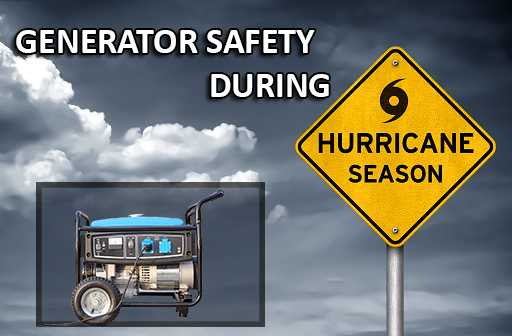
Generator Safety During Hurricane Season
8 Tips for Protecting Your Family
Each year, improper use of generators causes tragic deaths during hurricane and storm season. According to the American Journal of Public Health, carbon monoxide is responsible for 450 deaths each year and 15,000 ER visits. After Hurricane Laura’s recent landfall in Louisiana, The Louisiana Department of Health reported that more than half of the deaths were from carbon monoxide poisoning from portable generators.
How do these tragic deaths happen? People are focused on keeping the lights on and electricity running, and they don’t realize they’re putting their families in danger.
Carbon monoxide is a colorless, odorless, and tasteless gas that can take as little as five minutes to cause death.
Many people have a false sense of security when they use their generator outside or with partial ventilation. They don’t realize carports, garages, or placing a generator near a window can release toxic fumes inside the residence.
How to Use a Portable Generator and Prevent Tragedy
1. Never use a generator indoors, in basements, garages or in partially covered areas like carports. As mentioned above, partially open areas like carports are not safe for generator use—they don’t provide enough ventilation to prevent carbon monoxide poisoning.
2. Don’t place a generator up against your home. Carbon monoxide can flow in through windows, doors, and vents leaching toxic fumes inside. According to OSHA, generators should have 3-4 feet of space surrounding them on all sides (including above them). Not doing this will cause CO gas to build up around them.
3. To prevent a hot engine from igniting—always allow the generator to cool down after turning off before adding fuel. This will also prevent serious burn injuries.
4. Purchase a generator with an automatic safety shutoff. Some generators are now built with sensors that detect when CO has reached dangerous levels. While it’s still important to follow the above safety guidelines with your generator, it helps to have this extra measure of security. Read up on generator reviews to find out which models passed safety tests. As you know, not every product delivers what they promise.
5. Safely store gasoline for generator use away from flammable sources, including your generator. To prevent leakage and accidental fire, only use ANSI approved containers. Caution: never store gasoline inside your home!
6. If you don’t already have one, purchase a carbon monoxide alarm, and install one for each floor of your home. Regularly test your alarms to ensure they are working properly. According to The American Journal of Public Health, more than half of tested carbon monoxide detectors failed, setting off alarms too early or too late.
7. When using an extension cord, purchase one just for the purpose of using it with your generator. Make sure it is OSHA approved, bright and visible, and has passed safety tests. Again, check online reviews like these to ensure you’re buying a quality product that will last.
8. Talk to your family about how to use a generator safely. It’s important that everyone is aware of the high amount of risks and dangers and knows how to take the proper precautions. When is the best time to bring up the subject? Before a storm hits and your family isn’t in a panic trying to prepare. Knowing what to do ahead of time can prevent loss of life or property from rushed decision-making.
Using a generator for backup power offers the ability to keep the lights on, appliances running, and phones charging. These are valuable tools for making life more bearable when nature acts up. If you follow the safety tips above, you can rest at ease knowing your family is protected even if winds are raging outside.
Devastating generator accidents are 100% preventable. Don’t be a victim and don’t let your family or friends be either.
Please share this blog post with your loved ones. Following these generator safety guidelines can save many lives during a hurricane, storm, or power outage!